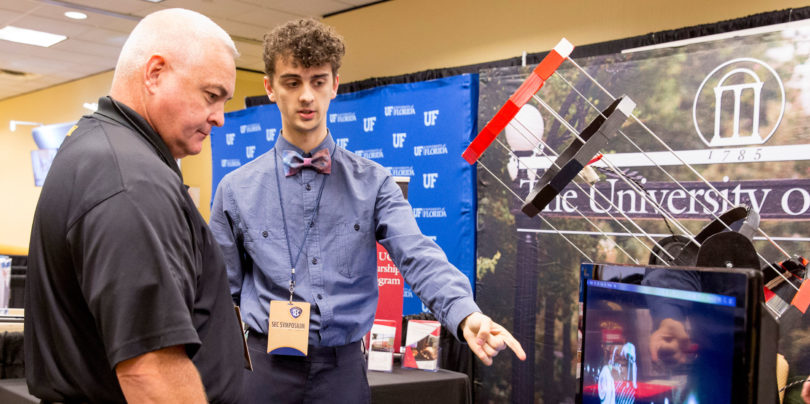By Stephanie Schupska, News Service
Spacey stares blankly at the ceiling, picking up details of the tiles and a few passersby’s faces as they glance momentarily into its parabolic mirror. With a few clicks of a mouse, the telescope swivels and tilts, showing its capabilities two stories underground to attendees of the 2015 Southeastern Conference Symposium at the Hyatt Regency Atlanta.
Its designers, University of Georgia undergraduates Caleb Adams, Jaicob Stewart and several of their friends, gave up buying a couch and a TV to purchase the 3-D printer that brought the telescope to life. After four days of running the printer nonstop, they had all the red and black parts they needed to put the Spacey Smart telescope together. With a Raspberry Pi-a tiny credit-card-sized computer-attached at its base, eight AA batteries powering the system and a Web app nearing final stages of development, they were eager to display their technical and applicable prowess for an academic audience in Atlanta.
For a crowd expecting university exhibits focused on creativity, innovation and entrepreneurship, theirs was a perfect fit.
SEC Symposium
In a conference known for its athletic abilities, the annual SEC Symposium is designed to showcase the academic strengths of its 14 member institutions. This year’s gathering, held Sept. 20-22, explored the role of the university in preparing individuals to be creative, innovative, entrepreneurial thinkers and evaluated ways in which universities serve as drivers of economic development throughout the nation.
 Caleb Adams, a fourth-year computer science major at the University of Georgia, gives Libby Morris, left, director of UGA’s Institute of Higher Education, a virtual tour of the Spacey Smart telescope’s capabilities while Helena Bales, a junior at Oregon State University who is designing Spacey’s Web application, looks on. (Photo by Dorothy Kozlowski/UGA)
Caleb Adams, a fourth-year computer science major at the University of Georgia, gives Libby Morris, left, director of UGA’s Institute of Higher Education, a virtual tour of the Spacey Smart telescope’s capabilities while Helena Bales, a junior at Oregon State University who is designing Spacey’s Web application, looks on. (Photo by Dorothy Kozlowski/UGA)
Panel presentations by faculty and administrators, keynote speeches, a grad school Q&A and a pitch session that would have included Spacey if his builders hadn’t already been earning a certain level of income-Stewart is lead iOS developer for Athens-based Axon Tutors-rounded out the Sunday-to-Tuesday conference.
“It’s been great to see what other universities are doing,” said Bob Pinckney, director of UGA’s entrepreneurship program. “There’s so much going on in education and entrepreneurship. The symposium provided a needed opportunity for us to learn from each other.
“Plus, we’ve got the best students in the universe, and it’s nice to showcase them doing awesome things.”
Spacey Smart telescope takes shape
Adams and Stewart, both fourth-year students at UGA, built their first telescope on a whim. They wanted a mental challenge, and Virginia Tech was hosting a hackathon. Their four-member team had missed the entry deadline, so organizers told them to bring a notepad and camera and allowed them in as student media. After a few hours of intense focus and a lot of contemplation, they came home with a working telescope-and as first place winners.
Spacey is the latest version of their work. It cost $250 (minus the money for a 3-D printer) to put together, and it operates a little differently than the average refractor or reflector telescope. Instead of a person looking through an eyepiece, the remote operation telescope-with 170 times magnification-collects light in its mirror and aims it at a small digital camera, which translates the images into viewable form through a web application.
The team has created both the hardware and software to run Spacey, and Helena Bales, a junior at Oregon State University who flew in for the conference and is Adams’ girlfriend, is finishing up the Web app — located at www.spacey.io — that will allow anyone with an interest in space to share images and ideas. Hollis Neel, a junior math major at UGA, designed the telescope’s mechanics.
“We all got a house together-six computer science students together-and watching it come together over the last week has been really exciting,” Stewart said. They’ve tested it in a few locations — a driveway in Atlanta, a cul-de-sac in Athens. “It’s cool to build these products that make space accessible for anyone anywhere.”
They’re working with UGA’s Thinc. Accelerator program to bring their concept to the marketplace.
“Spacey is completely self-contained. You can purchase your own and have nearly unlimited access to space,” said Adams, who rocked a space-print bowtie and socks at the symposium. “We’ve designed it so you can share images easily.”
Spacey is more than the name of their telescope. It’s also the name of their startup company, dedicated to bringing space closer to the public with the goal of building open-source telescopes and satellites for popular astronomical purposes, according to their website.
 Pamela Whitten, center, UGA provost and senior vice president for academic affairs, discusses innovation and entrepreneurship during the SEC Provosts Panel. (Photo by Dorothy Kozlowski/UGA)
Pamela Whitten, center, UGA provost and senior vice president for academic affairs, discusses innovation and entrepreneurship during the SEC Provosts Panel. (Photo by Dorothy Kozlowski/UGA)
Up next: CubeSat
Their next project is more academia in its aim, and, with enough funding, will be hitching a ride on a NASA rocket and making its home in space.
Called a CubeSat, a miniaturized satellite that usually has a volume of 1 liter and typically weighs less than 3 pounds, the satellite will head into space when the team has enough funding-and a rocket has enough leftover cargo space. They’re working both with faculty at the university and with alums, particularly Roger Hunter, the associate director for programs at the NASA Ames Research Center.
“We’re developing UGA’s first small satellite,” said Adams, who worked at the Johnson Space Center over the summer and learned NASA’s methods for its satellites. “So what this will do is look at wetlands, estuaries and oceanic environments to give UGA researchers the exact data that they want, and not just trickle-down data from someone else. We’re on the ground, designing this for them.”
For more information on Spacey, visit www.spacey.io. The website is currently registering subscribers for early access to their services. For more information on UGA’s Entrepreneurship Program, contact Pinckney at 706-542-9753 or bobpinckney@uga.edu.






